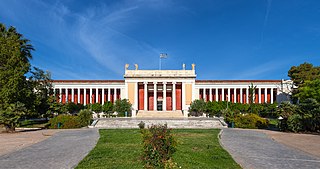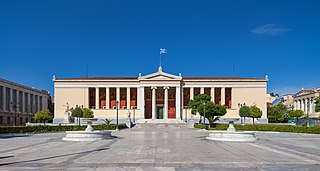
Ioannis Georgiadis was a Greek fencer. He competed at the 1896 Summer Olympics in Athens, the 1906 Intercalated Olympics and the 1924 Summer Olympics in Paris.

The National Archaeological Museum in Athens houses some of the most important artifacts from a variety of archaeological locations around Greece from prehistory to late antiquity. It is considered one of the greatest museums in the world and contains the richest collection of Greek Antiquity artifacts worldwide. It is situated in the Exarcheia area in central Athens between Epirus Street, Bouboulinas Street and Tositsas Street while its entrance is on the Patission Street adjacent to the historical building of the Athens Polytechnic university.

The National and Kapodistrian University of Athens, usually referred to simply as the University of Athens (UoA), is a public university in Zografou, a suburban town in the Athens agglomeration, Greece.

Spyridon-Adonis Georgiadis, commonly known as Adonis Georgiadis, is a Greek politician, author, publisher and former telemarketer. Often described as being on the far right of the political spectrum, he currently serves as Vice President of New Democracy and Minister for Health in the Second Cabinet of Kyriakos Mitsotakis. He previously served in the same cabinet as Minister for Labour and Social Security (2023–2024), Minister for Development and Investment in the First Cabinet of Kyriakos Mitsotakis (2019–2023), Minister for Health in the Cabinet of Antonis Samaras (2013–2014) and Deputy Minister for Development, Competitiveness and Shipping in the Cabinet of Lucas Papademos (2011–2012).
The Faculty of Geology is part of the School of Sciences in National and Kapodistrian University of Athens.

The Numismatic Museum of Athens is one of the most important museums in Greece and it houses a collection of over 500,000 coins, medals, gems, weights, stamps and related artefacts from 1400BC to modern times. The collection constitutes one of the richest in the world, paralleled by those of the British Museum in London, the Bibliothèque Nationale in Paris, the State Hermitage Museum in St. Petersburg, the Bode Museum in Berlin, and the American Numismatic Society in New York. The museum itself is housed in the mansion of the archaeologist Heinrich Schliemann, formally known as Iliou Melathron.

Polychronis Lembesis, was a Greek painter, a member of the Munich School of Greek artists.

The National Historical Museum is a historical museum in Athens. Founded in 1882, is the oldest of its kind in Greece. It is located in the Old Parliament House at Stadiou Street in Athens, which housed the Hellenic Parliament from 1875 until 1932. A branch of the National History Museum has been organized and operated there since 2001.
The Capodistrias Museum – Center of Capodistrian Studies (Greek: Μουσείο Καποδίστρια–Κέντρο Καποδιστριακών Μελετών) is a museum dedicated to the memory and life's work of Ioannis Kapodistrias. It is located in the area Koukouritsa of Evropouli in Corfu, Greece. Τhe museum is dedicated to the life and work of Ioannis Kapodistrias who was the First Governor of Greece, Minister of Foreign Affairs of the Russian Empire and a great diplomat, politician, physician.The property was donated by Maria Desylla-Kapodistria great granddaughter of Georgios Kapodistrias, younger brother of Ioannis Kapodistrias and the only one of the brothers who got married. The museum was established in 1981. Ioannis Kapodistrias' summer home in the rural area of Koukouritsa in his birthplace of Corfu, houses the museum, showcasing exhibits commemorating his life and accomplishments. Maria Desylla-Kapodistria, a former mayor of Corfu (1956–1959) and the first female mayor in Greece, donated the residence to the three primary cultural societies of Corfu. specifically for that purpose. The museum also functions as a centre for Kapodistrian and Corfiote studies.

The Archaeological Museum of Messenia is located in Kalamata, the capital of Messenia in southern Greece. It is in located in 3, Agiou Ioanni street.

Timoleon Filimon was a Greek journalist, politician, intellectual and tutor of King George I. He was one of the founding members of the Historical and Ethnological Society of Greece.

Yiannis Melanitis is a Greek conceptual artist, sculptor, painter, installation artist and digital artist born in Athens in 1967. In 2016, he was elected assistant professor at the Sculpture Department of the Athens School of Fine Arts. Melanitis' work uses hybrid art forms initially with concepts from philosophy and the sciences. His research focuses on the role of information on the arts considering "Information as the New Conceptualisation".

The Pamphlet of Rigas Feraios is a large chalcography printed in Vienna in 1797 by Rigas Feraios. It depicts a portrait of Alexander the Great framed by war scenes and portraits of his generals. The etching was incised by François Müller, who cooperated with Rigas for his cartographic work which he published the same year: Rigas' Map of Greece (1797), the New Map of Wallachia and part of Transylvania (1797) and the General Map of Moldavia (1797). It was released in 1200 copies from the printing press of Nitsch. One of the two copies that have been discovered in Greece is displayed in the National Historical Museum of Greece.
The Peloponnesian Folklore Foundation ‘Vas. Papantoniou’ or PFF is a nonprofit cultural institution and museum based in Nafplion, Greece. It was founded in 1974 by the folklorist and scenic designer Ioanna Papantoniou in memory of her father Vasilios Papantoniou. The aim of PFF is the research, preservation, study and presentation of the material culture of the Greeks.

FYTA are an Athens-based conceptual art and performance art duo. Their work problematises Greek identity and nationalism. FYTA's work combines different media and disciplines mostly operating within the wider framework of overidentification, queer politics and anti-humanist art, while they aim at a performative destabilisation of concepts of truth and nature / the natural.

Anna Apostolaki was a Greek archaeologist and museum curator. She was the first Greek woman to work as a professional archaeologist and served as curator and later the director of the National Museum of Decorative Arts. One of the first women to graduate with a doctoral degree, she was also the first woman member of the Archaeological Society of Athens and an early member of the Christian Archaeological Society. She was an expert in ancient textiles and saw preservation of ancient patterns and Greek weaving traditions as a means to not only support women's traditional work, but bolster Greek nationalism in the interwar period of Greek history.

Nefeli Mousoura is a Greek classical pianist.

Ioannis Vroutsis, commonly shortened to Giannis (Γιάννης), is a Greek economist, lawyer and politician serving as Alternate Minister for Sport in the Second Cabinet of Kyriakos Mitsotakis from July 2023. He has served as a member of parliament for the Cyclades since 16 September 2007.

Iraklis Mitsopoulos was an author, biologist, archaeologist, physicist, zoologist, paleontologist, mineralogist, geologist, and professor. He is considered the father of modern natural sciences in Greece. He taught classes for over forty-seven years of his life. His nephew world renowned Greek geologist Konstantinos M. Mitsopoulos became the first student to receive a doctorate degree in the natural sciences at the University of Athens. His son Maximos Mitsopoulos also became a geologist. Hercules co-founded the Museum of Physical Geography in Athens, Greece, and directed its Zoological Department. He was the founder and lifelong President of the Zoological Department at the Museum of Paleontology, Geology, Zoology, and Botany. The museum is part of the University of Athens. He built the framework of modern Greek natural scientific education.

Anastasios "Tasos" Dimos is a Greek painter and sculptor. He was born in Athens in 1960, and he studied at the Athens School of Fine Arts (A.S.F.A.). His resume includes over a hundred solo and group exhibitions. His paintings are featured in many public and private collections in Greece, the United States, Japan, Switzerland, the United Kingdom, Germany, Cyprus and Saudi Arabia.

















